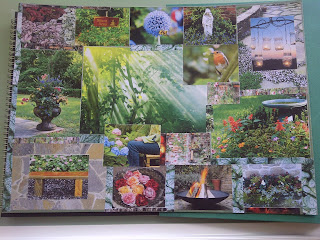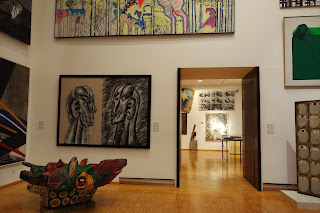Concept Boards and Why I Love Using Them
The process behind landscape design can be lengthy and at times arduous. All your creative energy funnels into one design project and then you may be asked to be involved in another. You then have to summon the same creative energy to produce another design that looks just as inspired as your previous projects.
It is a very daunting task. Even the most experienced creative designers face this challenge and uncertainty that may arise. Stress, fatigue, creative block etc it is all part of the design process.
It is a very daunting task. Even the most experienced creative designers face this challenge and uncertainty that may arise. Stress, fatigue, creative block etc it is all part of the design process.
One method that I have been taught recently while studying garden design is the Concept Board or Mood Board. They essentially mean the same thing but for the purpose of this blog I shall refer to them as the 'concept board'. So what are they exactly? It is a method used whereby you collate images onto a large piece of hard board to convey a 'feeling' or 'mood' that your proposed design will create for the client. Sometimes words on paper are simply not enough, which is why images and symbols come into play. More often than not images carry far more emotion and meaning when we look at them, more so than words on paper. Consider the emotions that arise when you come across a photograph you haven't looked at in ages, whether it be person or a place. It can really hit home. Sometimes it's happy other times it's going to be sad. Either way, you're going to feel something. With careful consideration and thought your next concept board should, hopefully, produce the same response - albeit a happy one of course!
Before we start let me begin by saying, concept boards are abstract and not literal. In other words a designer will use images and not words to express what they want their design project to convey. You're not so much as telling the client what your proposed design will be but showing them. In doing so you are capturing the essence of your proposed theme. Designers aren't alone in using this technique. Successful authors employ the same method as well using setting and mood to to convey a message or a character trait. And this is why I love using them and spending long hours sourcing images to cut out, edit, and stick down on hard board before presenting this to the client. Believe me, once you have established a solid concept for a design project, it pretty much designs itself!
Where does inspiration for a concept board board come from? From a variety of sources.
- The senses
- The garden itself
- The location
- The client brief (based on the interview notes between yourself and the client)
- The client themselves
- Yourself
Speaking personally the way I stimulate my creativity is to simply remind myself that I am a creative person. Sounds over confident? Absolutely not. Otherwise why did I pursue garden and landscape design as career in the first place? Could it be because I love gardens and creating them? Yes, I think it could be just that. So when you're sitting alone at your design desk looking at your collection of images you've amassed don't rely too much on logic to convey emotional meaning, just go with the flow, trust your heart and allow yourself to be open-minded. This is the essence of any creativity whether you're song-writer or a garden designer, the same approach will always apply. Allow your subconscious to speak to you. Allow yourself to be childlike and foolish. You're putting together a concept board. This is why they're so fun to make and, more importantly, why they work.
Of course you can use singular key words to help get the creative ball rolling, and to then match images to these key words. This is particularly effective if you space these key words on a large chart and then match images to these words. Some design teachers refer to this as 'Mind Mapping'. It can be very effective if you become stuck in trying to convey your concept. But the main thing to remember when matching images to words is to avoid being too literal. Abstract is the key. Show the client the mood of your design not tell the client. Try it.
So you have now compiled a nice collection of beautiful images at your disposal and you're ready to make a concept board to present to your client. Try to avoid using images of actual gardens. By that I mean images of the whole garden. The reason being is that you don't want the client assuming this is what they're getting (it may not even be close to what the client actually wants anyway). Worse still is that they may even write you off as being lacklustre and unimaginative. And if you're someone who prides themself on being creative you really wouldn't like your client to have this assumption about you. Instead, use a small section of the garden image and make it slightly abstract. It is less literal and conveys a particular mood and setting. Structure also plays a crucial part in your composition. How are you going to layout the images on your concept board. Do you want it to look minimalist or a dense patchwork of colour, for example. Depending on what the client wants and the mood you're aiming to achieve they both have merit but only one will probably work.
Some design schools encourage their students not to incorporate pictures of pieces of furniture, materials, gardens, or anything else that might have your intentions being misunderstood. To be honest, I'm inclined to actually disagree with this idea up to a point. While I appreciate their reasoning it does come down to how you use the image of a furniture piece within the context of the concept board. If you look at the image of my concept board that I have included in this blog you'll notice that there is indeed a piece of furniture. A rustic park bench. But the reason why I have included this image here is because the mood and theme of the garden I was designing was a meditation garden for a household of nuns who relish their quiet time for contemplation. Moving on . . .
If you are creating a formal concept board for a potential client here are five principals I try my best to adhere to. They work for me:
- Colour
- Texture
- Mood
- Style
- Emotion
Edit and don't be shy about it! Try not allow a duplication of similar striking images i.e. two bird baths or two water features. One good image that grabs your attention is far better than multiple images of the same thing. One red robin is great. Four red robins? Not so good. Hang onto your pictorial leftovers for next design project. There will be more! As mentioned earlier on in this blog abstract imaging can really speak to the heart of those looking at your images. You don't know why you're feeling it, you just are because you're capturing the essence of what your client wants. Take care in the presentation of your images.Your concept board proves your attention to detail.
After it's complete and presented to the client hang onto them. Create an concept board archive and when you do ask yourself this question, "Does my collection of concept boards suggest a cohesive look and signature style?" It's going to take me a while before I arrive at my own signature style, but I am certainly working on it!





Comments
Post a Comment